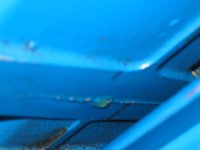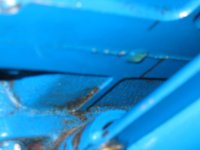First, I would make certain that that was where it was coming from, clean the area again and observe; if it's a casting seep it will remain the same whether the machine is running or not, and seep at a constant rate.
To prep the area, which is somewhat hard to get at, I'd use a Dynafile (small air powered belt sander that's wicked-cool at getting into tight spaces) and dress the casting ridge and surrounding area for a fiberglass patch. Since gravity will be working against you on this, I'd do the patch by laying out a block of wood, like a 8-10" chunk of 2x4, a piece of inner tube or other compressible material which will allow the glass cloth to conform to the casting. Some cling film or a plastic bag so the rubber won't stick to the patch, then the glass cloth patch and resin.
Do a final clean with acetone on the casting just before applying the resin and patch to remove the last traces of hydraulic oil, place the wooden block with the patch over the area and secure with a bottle jack. Depending on how hot you mix the resin, it shouldn't have to sit for more than a day. Usually the cup and brush you use to mix and apply are used as a control sample to tell when it has cured as it's practically impossible to clean these for reuse.
Once it's cured, remove the jack, the cling film should have acted like a release agent and kept everything else from sticking to the patch.






